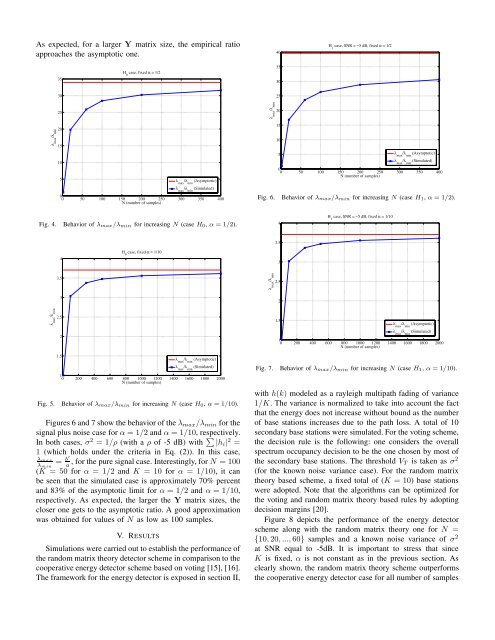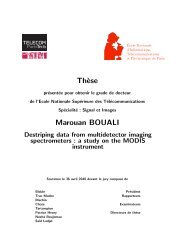Cooperative Spectrum Sensing Using Random Matrix Theory - HAL
Cooperative Spectrum Sensing Using Random Matrix Theory - HAL
Cooperative Spectrum Sensing Using Random Matrix Theory - HAL
You also want an ePaper? Increase the reach of your titles
YUMPU automatically turns print PDFs into web optimized ePapers that Google loves.
As expected, for a larger Y matrix size, the empirical ratio<br />
approaches the asymptotic one.<br />
40<br />
H 1<br />
case, SNR = −5 dB, fixed α = 1/2<br />
35<br />
H 0<br />
case, fixed α = 1/2<br />
35<br />
30<br />
30<br />
25<br />
25<br />
λ max<br />
/λ min<br />
20<br />
λ max<br />
/λ min<br />
20<br />
15<br />
10<br />
5<br />
λ /λ (Asymptotic)<br />
max min<br />
λ max<br />
/λ min<br />
(Simulated)<br />
0<br />
0 50 100 150 200 250 300 350 400<br />
N (number of samples)<br />
15<br />
10<br />
5<br />
λ max<br />
/λ min<br />
(Asymptotic)<br />
λ max<br />
/λ min<br />
(Simulated)<br />
0<br />
0 50 100 150 200 250 300 350 400<br />
N (number of samples)<br />
Fig. 6. Behavior of λ max/λ min for increasing N (case H 1 , α =1/2).<br />
Fig. 4. Behavior of λ max/λ min for increasing N (case H 0 , α =1/2).<br />
4<br />
H 1<br />
case, SNR = −5 dB, fixed α = 1/10<br />
3.5<br />
4<br />
H 0<br />
case, fixed α = 1/10<br />
3<br />
3.5<br />
3<br />
λ max<br />
/λ min<br />
2.5<br />
2<br />
λ max<br />
/λ min<br />
2.5<br />
2<br />
1.5<br />
λ max<br />
/λ min<br />
(Asymptotic)<br />
λ max<br />
/λ min<br />
(Simulated)<br />
1<br />
0 200 400 600 800 1000 1200 1400 1600 1800 2000<br />
N (number of samples)<br />
1.5<br />
λ max<br />
/λ min<br />
(Asymptotic)<br />
λ max<br />
/λ min<br />
(Simulated)<br />
1<br />
0 200 400 600 800 1000 1200 1400 1600 1800 2000<br />
N (number of samples)<br />
Fig. 5. Behavior of λ max/λ min for increasing N (case H 0 , α =1/10).<br />
Figures 6 and 7 show the behavior of the λ max /λ min for the<br />
signal plus noise case for α =1/2 and α =1/10, respectively.<br />
In both cases, σ 2 =1/ρ (with a ρ of -5 dB) with ∑ |h i | 2 =<br />
1 (which holds under the criteria in Eq. (2)). In this case,<br />
λ max<br />
λ min<br />
= b′<br />
a<br />
, for the pure signal case. Interestingly, for N = 100<br />
(K =50for α =1/2 and K =10for α =1/10), it can<br />
be seen that the simulated case is approximately 70% percent<br />
and 83% of the asymptotic limit for α =1/2 and α =1/10,<br />
respectively. As expected, the larger the Y matrix sizes, the<br />
closer one gets to the asymptotic ratio. A good approximation<br />
was obtained for values of N as low as 100 samples.<br />
V. RESULTS<br />
Simulations were carried out to establish the performance of<br />
the random matrix theory detector scheme in comparison to the<br />
cooperative energy detector scheme based on voting [15], [16].<br />
The framework for the energy detector is exposed in section II,<br />
Fig. 7. Behavior of λ max/λ min for increasing N (case H 1 , α =1/10).<br />
with h(k) modeled as a rayleigh multipath fading of variance<br />
1/K. The variance is normalized to take into account the fact<br />
that the energy does not increase without bound as the number<br />
of base stations increases due to the path loss. A total of 10<br />
secondary base stations were simulated. For the voting scheme,<br />
the decision rule is the following: one considers the overall<br />
spectrum occupancy decision to be the one chosen by most of<br />
the secondary base stations. The threshold V T is taken as σ 2<br />
(for the known noise variance case). For the random matrix<br />
theory based scheme, a fixed total of (K =10) base stations<br />
were adopted. Note that the algorithms can be optimized for<br />
the voting and random matrix theory based rules by adopting<br />
decision margins [20].<br />
Figure 8 depicts the performance of the energy detector<br />
scheme along with the random matrix theory one for N =<br />
{10, 20, ..., 60} samples and a known noise variance of σ 2<br />
at SNR equal to -5dB. It is important to stress that since<br />
K is fixed, α is not constant as in the previous section. As<br />
clearly shown, the random matrix theory scheme outperforms<br />
the cooperative energy detector case for all number of samples
















